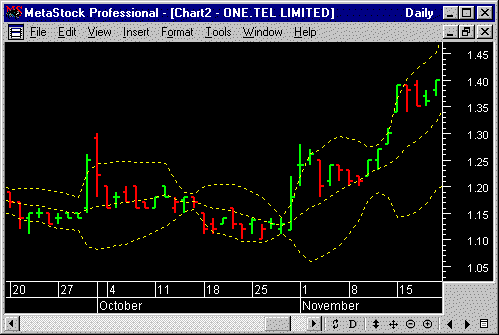|
Bollinger Bands

Description
Bollinger
Bands are a type of
envelope developed by John
Bollinger. However, where envelopes are
plotted at a fixed percentage above and
below a moving average, Bollinger Bands
are plotted at standard deviation levels
above and below a moving average.
You may
find the expert named "Equis - Bollinger
Bands" helpful in interpreting Bollinger
Bands.
Interpretation
When
displaying Bollinger Bands you are
required to select the number of periods
in the bands and the number of standard
deviations between the bands and the
moving average. Mr. Bollinger
recommends default values of "20" for
the number of periods, "simple" for the
moving average method, and "2"
deviations. He notes that periods of
less than 10 periods do not appear to
work very well.
Because the
spacing between Bollinger Bands is based
on the standard deviation of the
security, the bands widen when the
security becomes more volatile, and
contract when the security becomes less
volatile.
Mr.
Bollinger notes the following
characteristics of Bollinger Bands.
-
Sharp
price changes tend to occur after
the bands tighten, as volatility
lessens.
-
When
prices move outside the bands, a
continuation of the trend is
implied.
-
Bottoms/tops made outside the bands
followed by bottoms/tops made inside
the bands call for reversals in the
trend.
-
A move
that originates at one band tends to
go all the way to the other band.
This observation is useful when
projecting price targets.
|